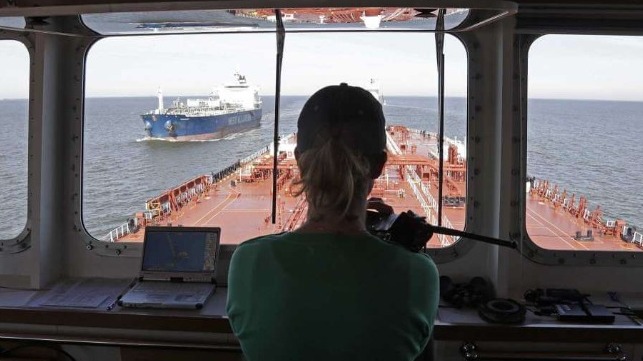Op-Ed: Vessel Speed Rules Must Take Navigational Safety Into Account

It is frustrating when anyone implies that pilots do not support efforts to protect the North Atlantic Right Whale (NARW). The American Pilots’ Association (APA) and pilot groups along the East Coast have worked with NOAA for decades to protect these whales. The principal purpose of compulsory pilotage is, after all, to protect the marine environment – including marine life – while keeping maritime commerce moving safely and efficiently. Pilots care immensely about the marine environment because they live, raise their families, and recreate on the waters they pilot.
On August 1, 2022, NOAA proposed major changes to the existing NARW Vessel Speed Regulations (VSRs), including applying the seasonal 10 knot speed limit to vessels over 35 feet (thus capturing all East Coast offshore pilot boats) and dramatically altering the VSR’s navigation safety deviation clause. These changes would have unintended consequences, including endangering pilots and reducing navigation safety for large vessels operating in East Coast Federal Navigation Channels (FNCs).
NOAA proposed these changes without, as required by law, considering key impacts of the proposal or equally effective alternative measures. For example, during an August 2021 webinar, NOAA admitted it had not considered numerous impacts of the proposed rule, including impacts on East Coast ports, but there has been no updated data since then. It is also significant that the District of Columbia Court of Appeals recently chastised NOAA on a similar rulemaking for the agency’s reliance “upon worst-case scenarios or pessimistic assumptions.” The Court went on to say that “[NOAA’s] role as an expert is undermined, not furthered, when it distorts that scientific judgment…to benefit a favored side.”
Pilots have significant personal and navigation safety concerns with NOAA’s proposal. First, limiting maneuvering speeds of pilot boats would make the already dangerous pilot transfer operation even more hazardous. Sadly, pilots die in the line of duty every year. Pilot boat operational capability is not a nicety, it is a necessity in an offshore environment. Second, to seasoned pilots, the experts on navigation safety, the idea that greater maneuvering speeds are required for large vessel in FNCs, especially in the winter months when the speed limits are in place, is seen simply as prudent seamanship.
Due to these safety concerns pilots worked with NOAA to include a navigation safety deviation clause in the current NARW VSRs. This clause authorizes masters/pilots to exceed 10 knots when “oceanographic, hydrographic and/or meteorological conditions severely restrict the maneuverability of the vessel.” [1] This clause allows masters/pilots to comply with the VSRs while also ensuring massive vessels are safely navigated in narrow channels that can extend 10-18 miles offshore along the East Coast. NOAA has not pointed to any concrete data to justify its proposed alteration of this vital clause.
A recent report by the special interest group Oceana claimed that “most vessels” are violating the VSRs. Yet, earlier this month, NOAA, in promoting its interactive speed zone dashboard, announced “high overall vessel compliance with mandatory [NARW VSRs].” Further, Oceana implied that all vessels that exceed 10 knots are in violation of the regulations. This characterization ignores that the VSRs include the navigation safety deviation clause and that many large vessels operating in FNCs must utilize this clause.
APA’s written comments to NOAA explain in detail pilots’ concerns with NOAA’s proposed VSR changes and make the following recommendations: 1) Exempt pilot boats from the VSRs; 2) Exclude deep draft vessels that are restricted by draft while operating in the East Coast FNCs from the VSRs; 3) do not alter the navigation safety deviation clause as proposed; and 4) utilize technology to more effectively establish targeted protective measures.
APA’s recommendation to exempt pilot boats from the VSRs would cover fewer than 25 [2] of the nearly 16,000 [3] small boats NOAA estimates would be covered by the amended NARW VSRs. NOAA has publicly conceded that there has never been a confirmed NARW strike by a pilot boat. Further, since pilot boats support compulsory pilotage laws, and law enforcement vessels are exempt from the current NARW VSRs, there is precedent to exempt pilot boats.
Similarly, regarding APA’s recommendation to exclude deep draft vessels operating in FNCs from the VSRs, NOAA has stated that it is not aware of a NARW strike by a piloted vessel in an FNC. Also, the area of FNCs that would be exempted account for less than 60 square miles of the 40,000 square miles of seasonal speed zones proposed by NOAA.
A 2022 NOAA assessment of the efficacy of the existing NARW VSRs notes the “positive effects the speed rule has had in reducing the number of serious injuries and mortalities of right whales,” [4] and also finds that “overall compliance with the speed rule continued to improve.”[5] If NOAA continues its public education efforts and implements APA’s recommendations, NOAA’s and APA’s shared objectives of protecting the NARWs and ensuring navigation and mariner safety can be accomplished.
 Clay Diamond was named Executive Director-General Counsel for the American Pilots’ Association (APA) in 2021. Prior to that, he served 13 years as APA’s Deputy Director-Associate General Counsel, and before that 20 years as a commissioned officer and Judge Advocate General (JAG) in the U.S. Coast Guard. A 1989 graduate of the Coast Guard Academy, he also earned a Master’s Degree from Rensselaer Polytechnic Institute, a Juris Doctor from Case Western Reserve University School of Law, and was a Fellow at the Massachusetts Institute of Technology Center for International Studies.
Clay Diamond was named Executive Director-General Counsel for the American Pilots’ Association (APA) in 2021. Prior to that, he served 13 years as APA’s Deputy Director-Associate General Counsel, and before that 20 years as a commissioned officer and Judge Advocate General (JAG) in the U.S. Coast Guard. A 1989 graduate of the Coast Guard Academy, he also earned a Master’s Degree from Rensselaer Polytechnic Institute, a Juris Doctor from Case Western Reserve University School of Law, and was a Fellow at the Massachusetts Institute of Technology Center for International Studies.
References:
[1] 50 CFR § 224.105(c)
[2] The APA proposal would exempt approximately 50 pilot boats from the NARW speed restrictions, but at any given time only half – or 25 – of these vessels would actually be underway.
[3] National Marine Fisheries Service, Draft Regulatory Impact Review and Initial Regulatory Flexibility Analysis, July 2022, at p. 31. https://media.fisheries.noaa.gov/2022-07/NARW_Proposed_Speed_Rule_RIR-IRFA%20_508_0.pdf
[4] Assessment at 36
[5] Id. at 35
The opinions expressed herein are the author's and not necessarily those of The Maritime Executive.
